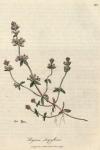
 Also see 109. Thymus vulgaris. Common Garden Thyme.
Also see 109. Thymus vulgaris. Common Garden Thyme.
Synonyma. Serpyllum, Pharm. Edinb.
Serpyllum vulgare minus. Bauh. Pin. p. 220. Park. Theat. p. 8.
Serpyllum vulgare. Gerard Emac. p. 570. Raii Hist. p. 521. Synop. p. 230.
Thymus foliis ovatis ad basin ciliatis. Hal. Stirp. Helv. n. 235.
Thymus Serpyllum. Hudson. Flor. Ang. p. 229. Withering. Bot. Arrang. p. 623. Curt. Flor. Lond.
α Serpyllum vulgare minus. Common smooth Mother of Thyme. C. B.
β Serpyllum foliis citri odore. Lemon Thyme. C. B.
γ Serpyllum villosum fruticosms, floribus dilute rubentibus. Ray Synop. Hoary Mother of Thyme.
δ Serpyllum angustifolium hirsutum. Hairy Mother of Thyme. C. B. See Hort. Kew.
Class Didynamia. Ord. Gymnospermia. Lin. Gen. Plant. 727.
Ess. Gen. Ch. Calycis bilabiati faux villis clausa.
Spec. Char. T. floribus capitatis, caulibus repentibus, foliis planis obtusis basi ciliatis.
The root is perennial, woody, fibrous, and of a brown colour: the stems are numerous, hard, square, branched, procumbent, and rise from four inches to a foot in height: the flowers are of a purplish colour, and stand in whorls towards the top of the stem and branches: the leaves are ovate, entire, smooth, beset with numerous small glands, fringed with hairs towards the base, and stand in pairs upon very short footstalks: the calyx, the corolla, and sexual parts, correspond with those mentioned of the Thymus vulgaris.It is a native of Britain, affecting heaths and mountainous situations, flowering in July and August.
It is observed by Mr. Curtis, that "few plants are subject to so many varieties as the Wild Thyme. In its most natural state, when found on dry exposed downs [It has been a received opinion, that this and other aromatic herbs give a flavour to the flesh of sheep that feed where these plants abound: but it is well known that sheep refuse these aromatics when they have a choice of other pasturage, Curt. See Account of Sheep Walks in Spain. Gent. Mag. 1764.] it is small and procumbent: when growing among furze or other plants, which afford it shelter, it runs up with a slender stalk to a foot or more in height, and assumes an appearance which might puzzle the young botanist." The specimen, from which the drawing for the annexed plate was taken, grew in a situation which subjected it to neither of these extremes; but it has been so far sheltered as to participate more of the character of the latter than the former. This plant has the same sensible qualities as those of the garden thyme, but has a milder, and rather more grateful flavour. "Its essential oil is both in smaller quantity, and less acrid, and its spirituous extract comes greatly short of the penetrating warmth and pungency of that of the other." [Lewis, M. M. p. 651.] From this it appears, that the Serpyllum, though possessing similar qualities, is evidently less medicinal than the foregoing species. [If this is the same as the Serpyllum of Dioscorides, he is of a different opinion, as he says, "Sylvestre ad medendi usum aptius quam sit hortense." Εγπυλλον, ab αγπω, according to Pliny, who commends its use in various diseases. L. xx. c. 22. See Diosc. L. iii. c. 46. Theop. 6. hist. 7. Serpyllum is thus mentioned by Virgil: Thestylis et rapido fessis messoribus aestu / Allia serpyllumque herbas contundit olentes. Ec. ii. 10.]

